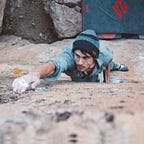The Injury
One day you’re climbing, and your finger starts hurting. It’s not like the usual fleeting pains that help build character — this one is persistent. You start out by denying its existence. By the end of the session, your finger is throbbing.
You think, “I will tape this finger, so as to avoid injury. Hah, I am so clever!” You clap your hands in excitement at your own godlike abilities of foresight. Your finger hurts when you clap your hands. You keep climbing, but with tape.
—
Next session, you’re halfway up the wall, and you hear a *pop*. You have heard through the grapevine that Popping Sounds Are A Bad Thing™.
But maybe what you heard was just your knuckle popping, or perhaps it was the sound of your general awesomeness breaking the sound barrier as you flew through the crux sequence of that desperate problem. It certainly wasn’t a partial rupture of the pulley…
(This would be the Denial stage, in case you weren’t paying attention)
—
A week later, your finger is feeling downright funky. You secretly know that you shouldn’t be climbing on it, but you think to yourself, “I’ll just climb something light, it will be like.. rehabilitation. I’m essentially doing PT!”
You get to the gym and climb easy things for a bit, and then a really fun problem, and then a hard problem… and before you know it, you’ve hurt your finger again, setting yourself back to square zero.
You quickly graduate from the denial phase, spending the next 4–12 weeks angrily recovering, coming to the gym only to gaze longingly at the walls while peddling your life away on a stationary bike.
You blaze through the bargaining and depression stages of your grief, and graduate to acceptance. You’ve become spiritual, embracing your position within the universe, exuding equanimity in all things. You don’t care about sending projects any more. What is a grade, if not a construct of mind?
You are but a spec on a rock, hurtling through the galaxy around the sun, which itself orbits an even greater centroid, cycling endlessly through time and space like the wheel of an immeasurably vast stationary bike.
—
Four months later you’ve recovered, and you’re sending hard things again. You’ve learned to listen to your body, you are so in touch with it. You don’t have the same fanatical attachment to pushing the envelope.
You’re a changed person.
(It could never happen again.)
Or could it …?
fin
—
This article was obviously a bit tongue-in-cheek. I don’t want you to walk away empty-handed, so here are some concrete steps you can take if you’ve actually hurt your finger:
- Stop climbing on it
- Stop climbing on it (like for real)
- Sleep / eat well
- Try buddy-taping it to give it support
- Try anti-inflammatory agents: natural ones (fish oil, turmeric / curcumin) and/or pharmaceuticals (ibuprofen, Alleve), depending on your personal beliefs / proclivities
- Do other exercise, particularly aerobic, to stimulate blood flow and help with healing — but make sure this exercise doesn’t aggravate said finger
Then just give it time. The body has an amazing capacity to heal itself.
